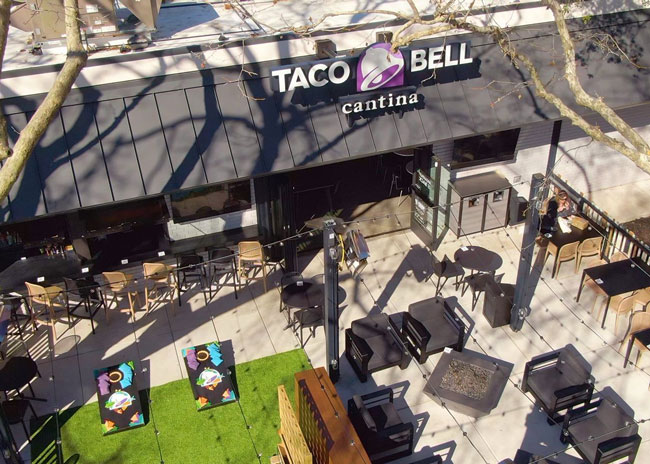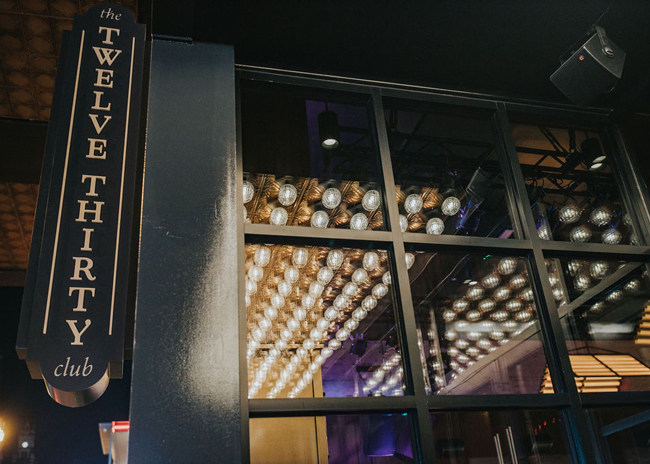In 2015 Taco Bell introduced its successful Cantina prototype, meant for urban locales it featured a lounge-like setting, the addition of booze and the absence of drive-thrus. In 2020, Taco Bell is evolving its Cantina concept again — and circling back to drive-thrus.
Earlier this year, Taco Bell and franchisee Diversified Restaurant Group collaborated to open the first drive-thru Cantina in Danville, Calif., merging proven Cantina success with the prioritization of drive-thru service during the pandemic. The first-of-its-kind restaurant features an outdoor firepit and game area, as well as full bar offerings for dine-in guests once it’s safe for to do so.
Evolving designs is nothing new at the Mexican QSR. In collaboration with its franchisees, Taco Bell has continued to evolve its restaurants on an ongoing basis. In navigating COVID-19, Taco Bell again adapted with improvements to digital and drive-thru offerings that prioritized safety and efficiency. Now, new builds and remodels will take modernization to new levels from coast to coast.
“Prioritizing our development plans continues to be a major focus for 2021, especially as we look towards building our next 1,000 restaurants,” says Mike Grams, Taco Bell’s president and global COO. “Our restaurant portfolio continues to rapidly evolve, striking a crucial balance between being technology-forward and social-oriented. Even amid the challenging pandemic, we are continuing to grow due in large part to the strength in our franchise partnerships as well as the flexible formats we offer.”
“I’ve been in the real estate and development business for decades,” says SG Ellison, president of Diversified Restaurant Group. “The partnership we have with Taco Bell is unique — the brand empowers us franchisees with both autonomy and support, which has allowed my business to not just build traditional restaurants but create destinations such as our flagship Taco Bell Cantina in Las Vegas, as well as our Cantinas in Pacifica and now Danville.”
While the brand will continue building destination restaurants, it will simultaneously prioritize digital elements to maximize efficiency for on-the-go customers. One upcoming opening in the heart of Manhattan will be kiosk-focused for a completely digital yet in-person experience. Taco Bell will also continue rolling out its Go Mobile concept that it began testing last year, which features minimalistic physical spaces and dual drive-thru lanes.
The Go Mobile rollout has excited franchisees, especially Tina Reagan. As president and COO of franchise K-Mac Enterprises, Reagan is a leader in remodeling older Taco Bell restaurants and has recently been focusing on Go Mobile. “While new development is important, so is remodeling our existing restaurants to fit the needs of each trade area’s customers and surrounding community,” she says. “We are always looking to evolve to meet our guests’ needs and transforming to be more digital-forward is no exception. In the last year, we’ve remodeled three restaurants into our Go Mobile format, and plan to both remodel and build over 30 additional Go Mobile restaurants by year end.”
The Go Mobile concept’s concierge service of team members, known as “bellhops,” strive to improve drive-thru speeds even further with tablet ordering and curbside pickup. Expect to see up to 1,000 bellhops across the U.S. by the summer.
Lee Engler, CEO of Border Foods, is another Taco Bell franchisee pushing the boundaries of what future restaurants will look and feel like. In addition to working with the brand, Engler and his team invited experts outside of the QSR industry to help collaborate on a what they describe as an industry-defying restaurant, set to be revealed in the coming months. “As great as the drive-thru is, a fundamental flaw is bottleneck at the windows,” says Engler. “Our team has set out to creatively solve for that like no one else has done before, and we’re thrilled by positive early responses to our one-of-a-kind concept coming to Brooklyn Park, Minnesota.”




